Hot peppers are a versatile seasoning for fish, meat, and vegetable dishes, as well as a traditional remedy for various ailments. The flesh of hot peppers contains more vitamin C than lemons. Consuming hot peppers boosts immunity and helps fight bacteria and germs effectively. They can be grown in gardens, on balconies, or windowsills.
In this article, we explore which hot pepper varieties yield the best harvest and what to consider when choosing them.
Table of contents
Best Varieties
The choice of variety affects yield, appearance, and flavor. Some plants thrive in warm climates, while others produce stable yields in cooler regions like Scandinavia or the Alpine areas.
Seeds can be purchased online or from fellow gardeners. Below are the best hot pepper varieties, with details on yield, growing conditions, and photos.
Queen of Spades
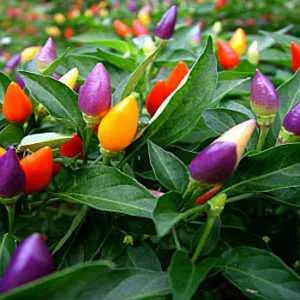 The ornamental Queen of Spades variety stands out for its striking appearance: small, glossy red, yellow, and purple peppers protrude from the bush in all directions. The compact bushes grow no taller than 40 cm. Leaves are dark green and small. Peppers measure 10 cm in length and weigh around 12 g.
The ornamental Queen of Spades variety stands out for its striking appearance: small, glossy red, yellow, and purple peppers protrude from the bush in all directions. The compact bushes grow no taller than 40 cm. Leaves are dark green and small. Peppers measure 10 cm in length and weigh around 12 g.
In winter, Queen of Spades can be grown indoors. This mid-season variety takes 100–115 days from germination to reach technical maturity. In summer, it can be planted in greenhouses or open ground.
The peppers have a rich aroma and flavor, making them ideal for powders and all-purpose seasonings.
Dragon’s Tongue
This hot pepper matures in 100–110 days after germination. The plant is resistant to diseases and pests, with up to 90 peppers ripening simultaneously on a single bush. In southern Europe, it’s grown outdoors, while in cooler regions, it thrives in greenhouses. The glossy, elongated red peppers measure 12 cm in length and weigh around 18 g. The bushes are sturdy and spreading, reaching 70 cm in height, with medium-sized green leaves.
Interesting! Dragon’s Tongue is used to make paprika, spices, and seasonings. The peppers have a strong, fiery aroma and flavor, commonly used in Mediterranean, Hungarian, and Asian cuisines.
Indian Summer
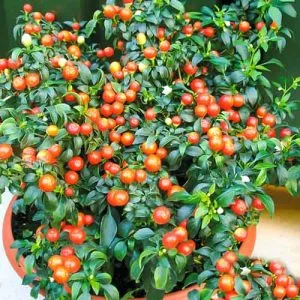
Indian Summer
In summer, this variety is grown on balconies or patios; in winter, it thrives on windowsills. While low-maintenance, it requires regular watering and organic fertilization.
The leafy bushes grow 30–40 cm tall. Peppers take about four months to mature and are small and spherical. The skin is glossy, smooth, and red. Each pepper weighs 5 g, with a wall thickness of 1 mm.
The peppers have a fiery taste and aroma and are versatile in use.
Serpent’s Fire
This hybrid pepper matures in 120–130 days after planting. Suitable for open fields and greenhouses, the compact bushes grow up to 60 cm tall with a well-developed root system.
The ribbed, cone-shaped peppers reach 12 cm in length. Each weighs 10–15 g, with 2–3 mm thick walls and a red color. Serpent’s Fire has excellent marketability, yielding about 4 kg per m².
Important! Serpent’s Fire is ideal for cooler climates. It is cold-resistant and adapts well to sudden weather changes. It rarely suffers from diseases or pests.
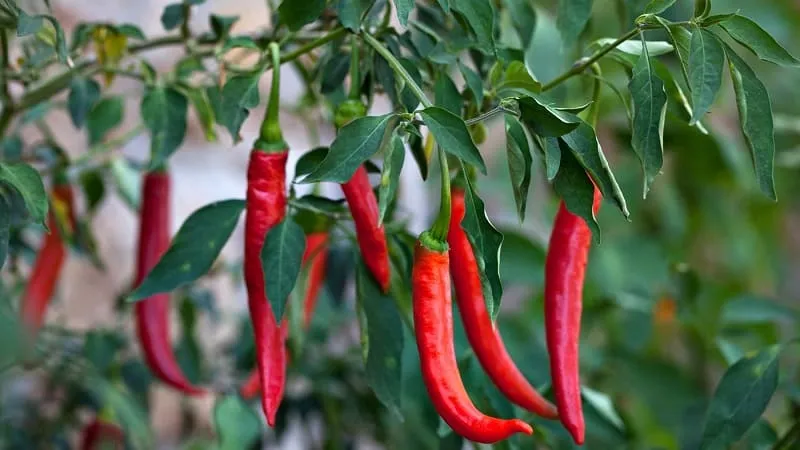
Pepper «Serpent’s Fire»
Troublemaker
This plant grows up to 80 cm tall, with semi-spreading, leafy bushes. Harvesting begins 120–130 days after planting. The trapezoidal peppers weigh 5–7 g and come in yellow, red, and orange. They have a semi-bitter, juicy flesh and excellent flavor. The fruiting period is extended, and the variety is versatile in use.
Gomera
The Gomera hybrid is resistant to pests and easy to care for. Compact and suitable for gardens or indoor growing, its peppers measure 18–22 cm long and are light green. The dense flesh has a pronounced spicy taste. Gomera is great fresh or for pickling and preserves.
Important! For higher yields, fertilize regularly with organic or mineral supplements like Compo, Substral, or a superphosphate solution. Sunlight and wind protection also boost productivity. In greenhouses, hot peppers grow well alongside cucumbers.
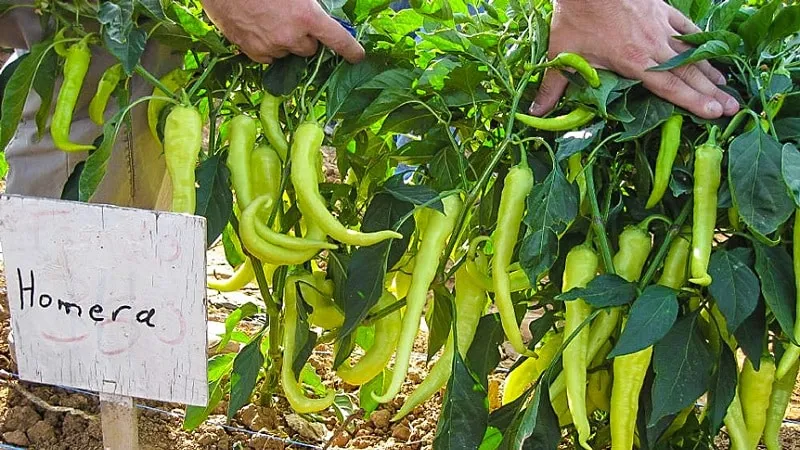
Pepper «Gomera»
Dinosaur
This hybrid matures in just 100 days and adapts to any climate. The plant grows 60 cm tall, with large, dark green leaves. The elongated peppers measure 20–22 cm long and weigh around 120 g, with 4 mm thick walls. At maturity, they turn honey-yellow and glossy. Gardeners love Dinosaur for its unique sweet-spicy flavor. It’s versatile, adding a piquant touch to dishes.

Pepper «Dinosaur»
Adjika
Popular hot pepper Adjika thrives in open fields. It requires minimal care. The bright red, cone-shaped peppers weigh 70–100 g, with thick, juicy flesh. Recognizable for its classic spicy taste and pleasant aroma, Adjika is used fresh, dried, or ground.
Important! For best yields, grow Adjika from seedlings. Disinfect seeds and soil before planting, and use a 50x50 cm spacing in the garden.
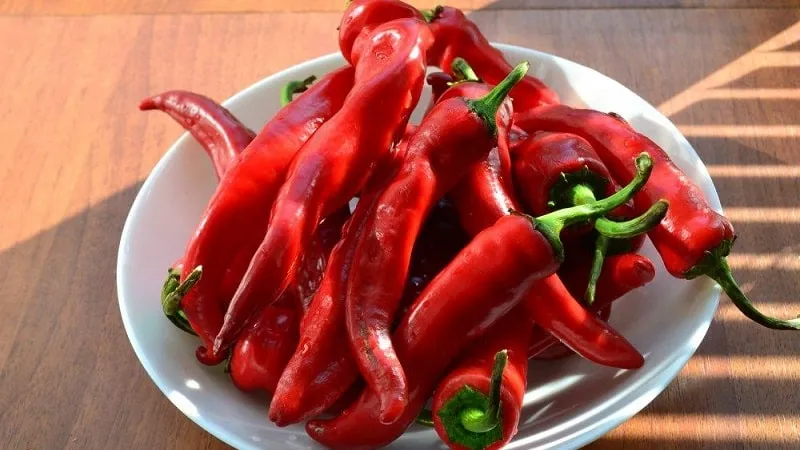
Pepper «Adjika»
Ram’s Horn
This mid-late variety matures in 130–140 days. The plant grows about 50 cm tall with moderate foliage. It prefers loose, nutrient-rich soil.
The cone-shaped peppers are elongated, averaging 40 g in weight and 30 cm in length. Red and juicy, they have a fiery taste and strong aroma. Each plant produces about 60 peppers, yielding 3 kg per m². Use them fresh, for spices, or pickling.
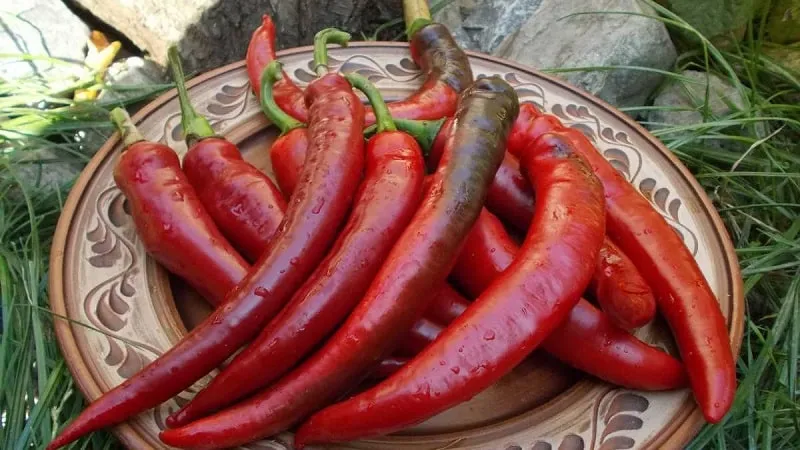
Pepper «Ram’s Horn»
Cayenne
The plant grows up to 90 cm tall, with small, light green leaves. This heat-loving variety yields best in greenhouses. The bright red, cone-shaped peppers weigh 80 g and measure 15–20 cm long. The dense flesh has a bold peppery flavor. Cayenne is versatile—great for drying or cooking.
Chinese Fire
Chinese Fire is easy to grow, maturing in just 90 days. Resistant to weather fluctuations, the plant reaches 60 cm tall. The curved, cone-shaped peppers weigh 50–80 g and measure 25 cm long. They have a sharp, spicy taste and store well, making them ideal for transport.
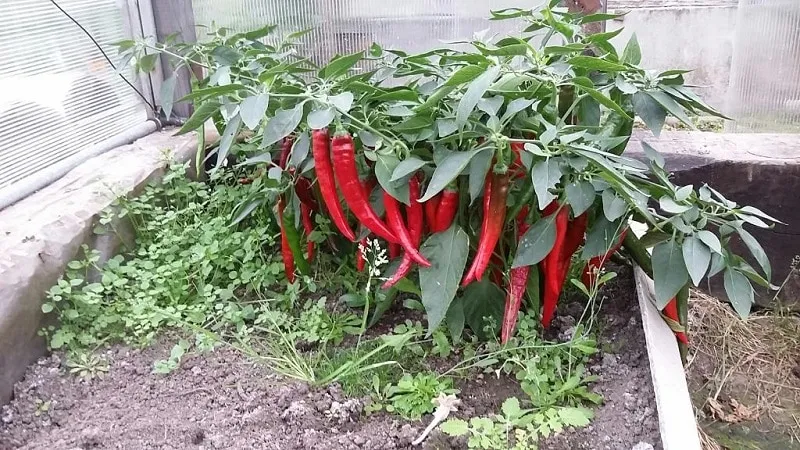
Pepper «Chinese Fire»
Hungarian Hot Wax
Compact plants thrive outdoors. The red peppers weigh 10 g, with 2 mm thick walls and a mildly spicy taste. They measure 7 cm long, with an extended fruiting period yielding 1.5–3 kg per m².
Interesting! Hot peppers are great for pickling and fermenting. They retain their vitamins, boosting immunity during flu season.
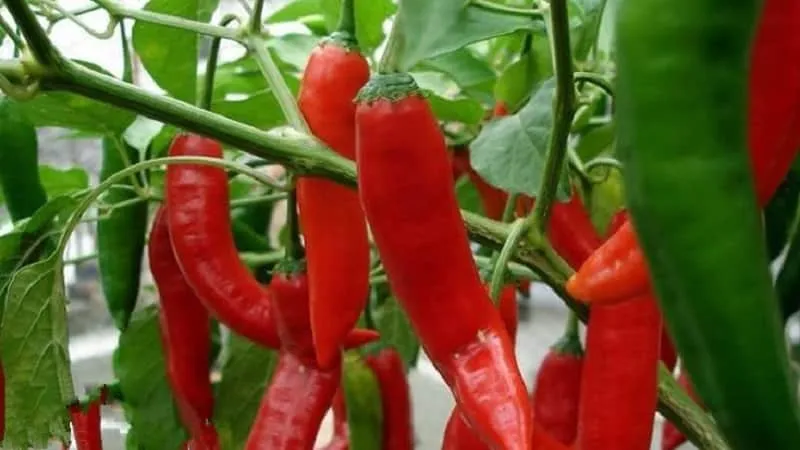
Pepper «Hungarian Hot Wax»
Best Hot Pepper Varieties for Greenhouses
In regions with unpredictable weather, greenhouses protect peppers from heavy rain, wind, and frost.
Top greenhouse varieties:
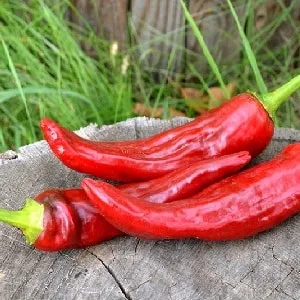
- Hungarian Hot. This mid-season variety is planted as seedlings, spaced 40x60 cm. The compact bushes grow 25–30 cm tall. The elongated, cone-shaped peppers have glossy red skin and a bold spicy taste. They store well.
- Anaheim. A type of chili pepper with green skin and a tangy flavor. Peppers measure 25 cm long and weigh 30–40 g. Great for sauces, spices, and marinades, they’re rich in vitamins A, E, and C.
- Impala. Tolerant of high humidity and resistant to viruses and fungi. The 70 cm tall plant produces medium-sized leaves and classic spicy red peppers weighing 80 g. Versatile and ideal for commercial growing.
For Open Fields
Open-field varieties are hardy and low-maintenance, resisting diseases and yielding well in varying conditions:
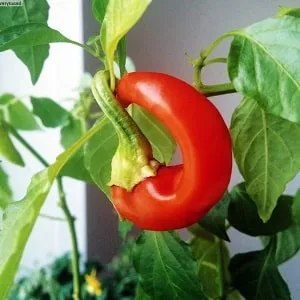
- Indian Elephant. Matures in 100–110 days, with excellent flavor and appearance. The sturdy, semi-spreading bushes reach 130 cm tall. Dark red, cone-shaped peppers weigh 30 g, with 1 mm thick walls and a sweet-spicy taste.
- Dagger. A hybrid grown from seedlings. The long, smooth-skinned peppers weigh 40–60 g, with 3 mm thick walls and a mildly spicy flavor. Great fresh or in salads and snacks.
- Pietro stands out with its dark red peppers and zesty aroma. Each weighs 30 g and measures 15 cm long. This low-maintenance hybrid resists tobacco mosaic virus and fungal infections.
Choosing Early-Maturing Varieties
Early varieties are ideal for cooler climates like Scandinavia or the Alps. Fiery Bouquet, Chinese Fire, and Double Abundance mature in 80–90 days, ensuring a harvest before the season ends.
Mid-Season Varieties
Mid-season peppers like Queen of Spades and Hungarian Hot mature in 100–120 days. They thrive in temperate European climates, offering stable yields and rich flavor.
Late-Season Varieties
Late varieties like Ram’s Horn, Dagger, and Cayenne take 130–140 days to mature. They grow well in southern Europe and are easy to care for, with excellent marketability.
Conclusion
Gardeners grow hot peppers from both local and international breeders. These peppers are essential for spicy dishes and can be enjoyed fresh or dried. Rich in vitamins and minerals, they boost health and immunity when consumed in moderation.
Peppers thrive outdoors, in greenhouses, or indoors. A unique trait is their ability to produce year-round. When selecting a variety, consider maturity time, yield, and care requirements.







